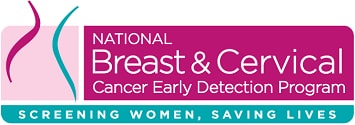

National Breast and Cervical Cancer Early Detection Program (NBCCEDP)
About the Program
Through the National Breast and Cervical Cancer Early Detection Program (NBCCEDP), CDC provides low-income, uninsured, and underserved women access to timely breast and cervical cancer screening and diagnostic services.
To improve access to screening, Congress passed the Breast and Cervical Cancer Mortality Prevention Act of 1990,[PDF-1MB] which directed CDC to create the NBCCEDP. Currently, the NBCCEDP funds all 50 states, the District of Columbia, 6 U.S. territories, and 13 American Indian/Alaska Native tribes or tribal organizations to provide screening services for breast and cervical cancer. The program helps low-income, uninsured, and underinsured women gain access to breast and cervical cancer screening and diagnostic services. These services include—
- Clinical breast examinations.
- Mammograms.
- Pap tests.
- Human papillomavirus (HPV) tests.
- Diagnostic testing if results are abnormal.
- Referrals to treatment.
In 2000, Congress passed the Breast and Cervical Cancer Prevention and Treatment Act,[PDF-173KB] which allowed states to offer women who are diagnosed with cancer in the NBCCEDP access to treatment through Medicaid. All 50 states and the District of Columbia approved this option. In 2001, with passage of the Native American Breast and Cervical Cancer Treatment Technical Amendment Act,[PDF-129KB] Congress explained that his option also applies to American Indians and Alaska Natives who are eligible for health services provided by the Indian Health Service or by a tribal organization.
Program Eligibility
Federal guidelines establish an eligibility baseline to direct services to uninsured and underinsured women at or below 250% of federal poverty level; ages 21 to 64 for cervical cancer screening; ages 40 to 64 for breast cancer screening. About 11.1% of U.S. women are eligible for NBCCEDP cervical cancer screening, and about 9.8% are eligible for breast cancer screening. The program serves 6.5% of eligible women for cervical cancer screening and 10.6% of those eligible for breast cancer screening.
Accomplishments
Since 1991, NBCCEDP-funded programs have–
- Served more than 5.4 million women.
- Provided more than 13.0 million breast and cervical cancer screening examinations.
- Diagnosed 65,879 invasive breast cancers and 21,126 premalignant breast lesions.
- Diagnosed 4,524 invasive cervical cancers and 207,727 premalignant cervical lesions, of which 39% were high-grade.
In program year 2017, the NBCCEDP—
- Provided breast cancer screening and diagnostic services to 285,504 women and diagnosed 2,521 invasive breast cancers and 765 premalignant breast lesions.
- Provided cervical cancer screening and diagnostic services to 138,590 women and diagnosed 168 invasive cervical cancers and 5,990 premalignant cervical lesions, of which 37% were high-grade.
To reach underserved women, the NBCCEDP Conceptual Framework supports an array of strategies, including program management, screening and diagnostic services, data management, quality assurance and quality improvement, evaluation, partnerships, professional development, and recruitment. Providers in the program work collaboratively to provide breast and cervical cancer screening, diagnostic evaluation, and treatment referrals (where appropriate). The program’s continued success depends in large part on the complementary efforts of a variety of national partner organizations, as well as on state and community partners.
Screening
Deaths from breast and cervical cancers could be avoided if cancer screening rates increased among women at risk. Deaths from these diseases occur disproportionately among women who are uninsured or underinsured. Mammography and Pap tests are underused by women who have no regular source of health care, women without health insurance, and women who immigrated to the United States within the past 10 years.1
Expanded Focus
Implementation of health care reform through the Affordable Care Act will increase access to breast and cervical cancer screening services for many low-income, underserved women through expanded insurance coverage and eliminating cost-sharing. But even with adequate health insurance, many women will still face substantial barriers to obtaining breast and cervical cancer screening such as geographic isolation, limited health literacy or self-efficacy, lack of provider recommendation, inconvenient times to access services, and language barriers.
CDC and other public health agencies now have an unprecedented opportunity to build on the existing capacity and the extensive clinical network of NBCCEDP by focusing on population-based approaches to ensure women overcome barriers to getting screened for breast and cervical cancer.
In addition to funding screening provision—reaching and serving NBCCEDP-eligible women—NBCCEDP supports planning and implementing activities to increase breast and cervical cancer screening rates among all women of appropriate screening age. This includes women who have—
- Health insurance, especially the newly insured.
- Publicly funded insurance, such as Medicare or Medicaid.
- Access to Indian Health Service or tribal health clinics.
- Coverage through other programs or services.
NBCCEDP-funded programs use population-based approaches to improve systems that increase high-quality breast and cervical cancer screening. Research suggests that social, organizational, and policy environments impact the ability or likelihood of individuals engaging in healthy behaviors, such as breast and cervical cancer screening. Behavior is difficult to change, especially in an environment that does not readily support change. Therefore, NBCCEDP has adopted the social ecological model, which not only focuses on the behavior choices of individuals, but also on organizational, community, and policy level factors that influence those choices.
Reference
1White A, Thompson TD, White MC, Sabatino SA, de Moor J, Doria-Rose PV, Geiger AM, Richardson LC. Cancer screening test use — United States, 2015.MMWR 2017;66(8);201–206.
























.png)









No hay comentarios:
Publicar un comentario